Microsoft virus – a set of threats that misuse the name of Microsoft to swindle users’ money or personal information
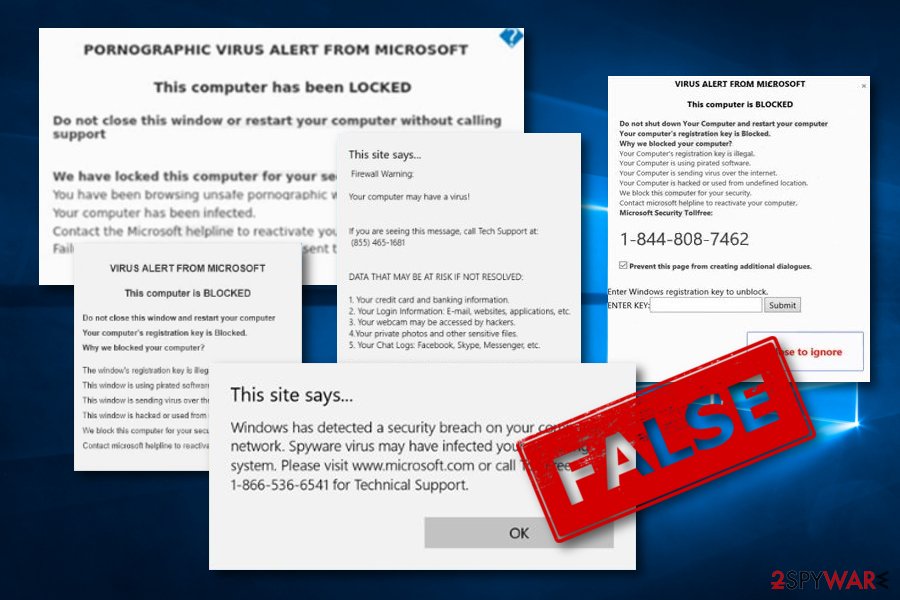
Microsoft virus – a term used to describe different types of threats which misuse the name of Microsoft

Microsoft virus – a term used to describe different types of threats which misuse the name of Microsoft
Microsoft virus is the name of different threats (scams, mostly) that are using the logo of Microsoft Corporation[1] to prove their legitimacy and trust. These malware series appear to be mostly scam applications that appear while browsing and start providing fake security alerts to urge users to call certified Microsoft technicians. Additionally, victims are asked to pay for the help which they don’t even need. This is the main reason why crooks decided to misuse the company’s name.
Due to the increasing rate of potentially suspicious and malicious infections that have been targetting Windows users via providing them with the original Microsoft logo, the Corporation itself released a guide on what kind of viruses are spread the most and how to prevent Microsoft virus and suspicious programs from sneaking into the targeted system.[2] However, the main thing to do is to disable the malicious master.exe or similar file and then reset the web browser.
| Name | Microsoft virus |
|---|---|
| Types | Scams, malicious files |
| Related malware |
|
| Aim | To swindle personal information or money, inject malware on the targeted machine |
| Distribution techniques | Scams related to Microsoft virus can be caused by adware or other potentially unwanted programs, malicious files, e.g. master.exe, often come as attachments to email spam |
| Browsers affected | Microsoft Edge, Google Chrome, Internet Explorer, Mozilla Firefox can be filled with rogue extensions and other helper components |
| Targeted operating system | Windows (all types of versions such as 7, 8, 10, etc.). However, the appearance of Microsoft malware is more common on Windows 10 as this OS is the most used one nowadays |
| Removal software | Download a tool such as Reimage Reimage Cleaner to detect all malicious entries and potentially unwanted content on your infected machine. After that, opt for the wanted removal method (automatical/manual) |
Microsoft virus is a very wide term which overtakes various PUPs and cyber threats. Usually, cybercriminals deliver scams by misusing this name. Such rogue applications are also known as technical support scams.[3] By providing fake information on supposedly infected computers, hackers trick users into calling the given mobile phone number.
If the victim decides to make a call via the provided fake technical support number, anything can happen. Once users are connected with fake help experts, they might be urged to provide some personal details about themselves or be convinced to install rogue repair software. As you can see, this type of Microsoft virus might be spread for very tricky purposes.
If you experience Microsoft virus on your computer system urging you to call certified Microsoft technicians, make sure not to dial the fake phone number as revealing personal information might relate to data theft in the future. Also, cybercriminals might find a way how to remotely gain access to your computer system if you reveal some crucial details to these people.
Microsoft virus removal is the best thing to do once infected with malware or a PUP. If it is a scam which has been lately triggering your normal work, there supposedly is an adware program on your computer system or another suspicious application that has been forcing the scam message to appear whenever browsing the Internet.
You can use the help of Reimage Reimage Cleaner to locate malicious or suspicious content on the infected machine. This should help you to remove Microsoft virus from your Windows OS. By the way, do not be surprised if you find some rogue content in web browser applications such as Chrome, Edge, Explorer, and Firefox that needs to be eliminated too.
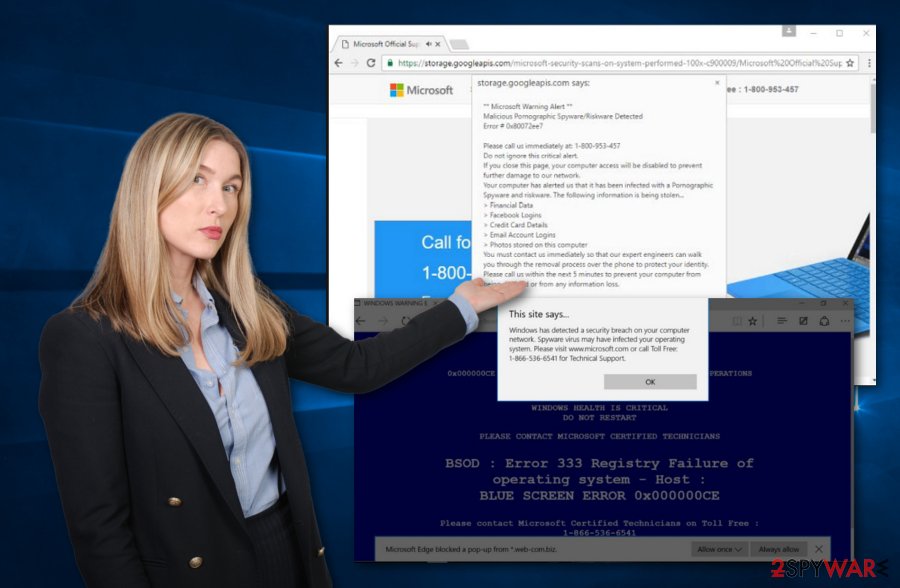
Microsoft malware is Microsoft-themed virus that can appear on Windows computers and start claiming false things

Microsoft malware is Microsoft-themed virus that can appear on Windows computers and start claiming false things
However, there might be other more dangerous malware forms lurking under the name of Microsoft. For example, in 2018 there were reports released that malicious payload (which includes ransomware viruses and dangerous Trojan horses) was delivered through infectious Microsoft Office documents and files.
Spotting dangerous infections, especially trojan and ransomware-based ones, signifies about possible system damage. These types of Microsoft viruses are the rarest but the most dangerous ones. Such infections can relate to theft of personal information, money swindling, permanent damage of crucial computer software, system resource overuse.
For further information, these versions of Microsoft virus are carried via infected documents that come attached to email spam. It is very important to scan all received email messages together with attached files in case some malicious objects are hidden there. Better be too cautious than not careful at all.
Most popular versions of Microsoft virus
PORNOGRAPHIC VIRUS ALERT FROM MICROSOFT
PORNOGRAPHIC VIRUS ALERT FROM MICROSOFT is considered to be a technical support scam that claims false things such as system damage while visiting pornography-themed websites for receiving calls from users. If you ever get a message from this type of Microsoft virus and it does not disappear after installing Adblock, there might be adware lurking in your system and forcing the appearance of this scam.
Once PORNOGRAPHIC VIRUS ALERT FROM MICROSOFT scam appears on your computer screen, you will supposedly notice it. The fake message claims that the computer is locked and users need to call the given mobile phone number for help. DO NOT dial this number as hackers might try to swindle your money for useless security software or trick you to provide personal data.
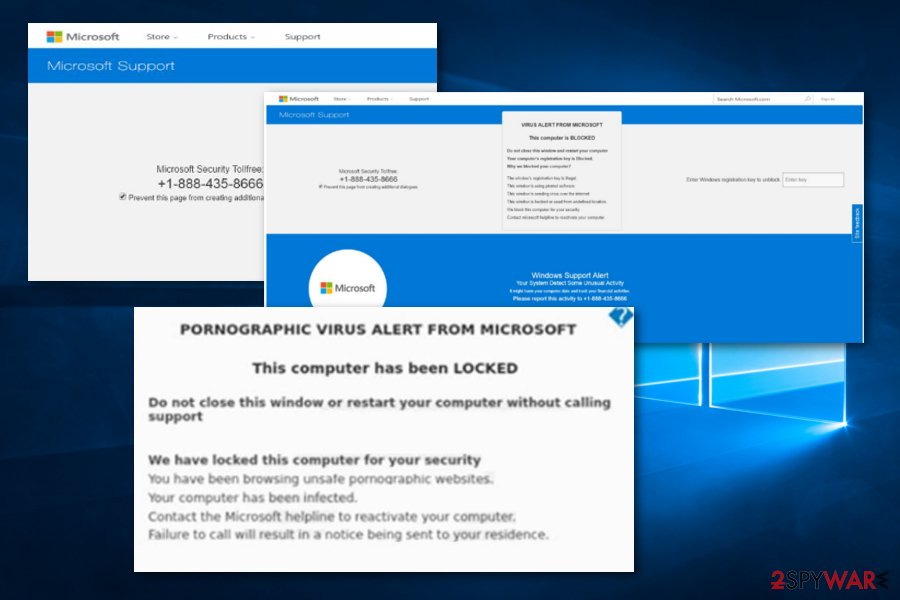
PORNOGRAPHIC VIRUS ALERT FROM MICROSOFT scam is a fake report that claims about strange malware found on the Windows computer

PORNOGRAPHIC VIRUS ALERT FROM MICROSOFT scam is a fake report that claims about strange malware found on the Windows computer
VIRUS ALERT FROM MICROSOFT
VIRUS ALERT FROM MICROSOFT is another scam that is very similar to the previous one. This message also claims that the computer is locked due to a malicious infection and the only way to repair the damage is to contact the fake Microsoft helpline. This technical support number also is another fake one.
If you read the message, you will find that Microsoft virus scam claims many strange things such as that your computer is spreading malware throughout the Internet sphere, is running third-party programs, has been hacked and that the fake experts have been locking the system for safety. DO NOT believe in such things, these are LIES.
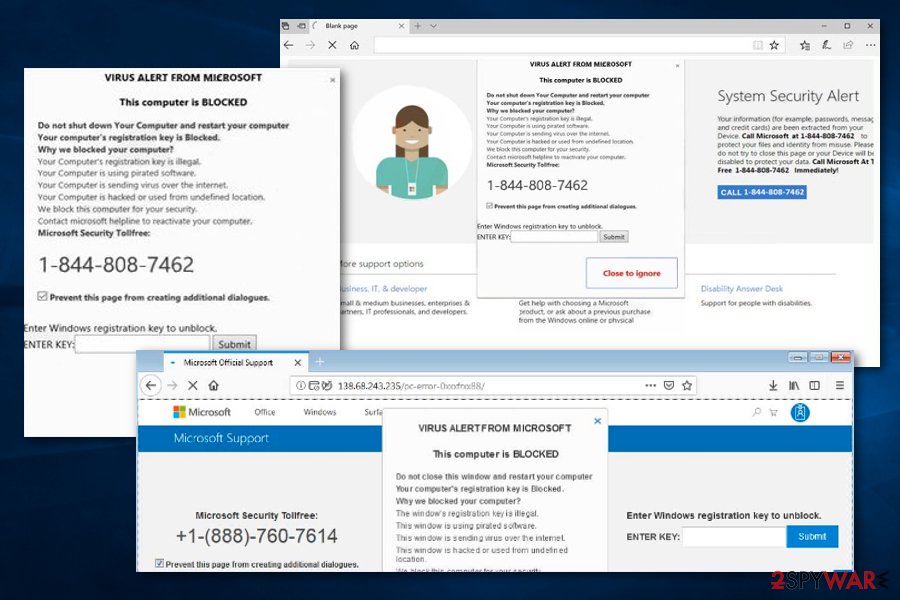
VIRUS ALERT FROM MICROSOFT is a scam that claims that users computers are infected with malware

VIRUS ALERT FROM MICROSOFT is a scam that claims that users computers are infected with malware
Microsoft Warning Alert
Microsoft Warning Alert, also known as Microsoft Spyware Alert, is a technical support scam. The fake scam message provides a “critical alert” that urges users to contact the 0-800-046-5729 mobile phone number for instant help. Hackers claim that if the alert window is closed, computer connection and system work will be disabled.
Continuously, these cybercriminals keep on lying further. They claim that such damage and errors appeared due to pornographic spyware and riskware. However, the true risk while dealing with Microsoft virus that you should worry about is calling the fake helpline which can try to swindle personal information about you or your system for malware exploitation.
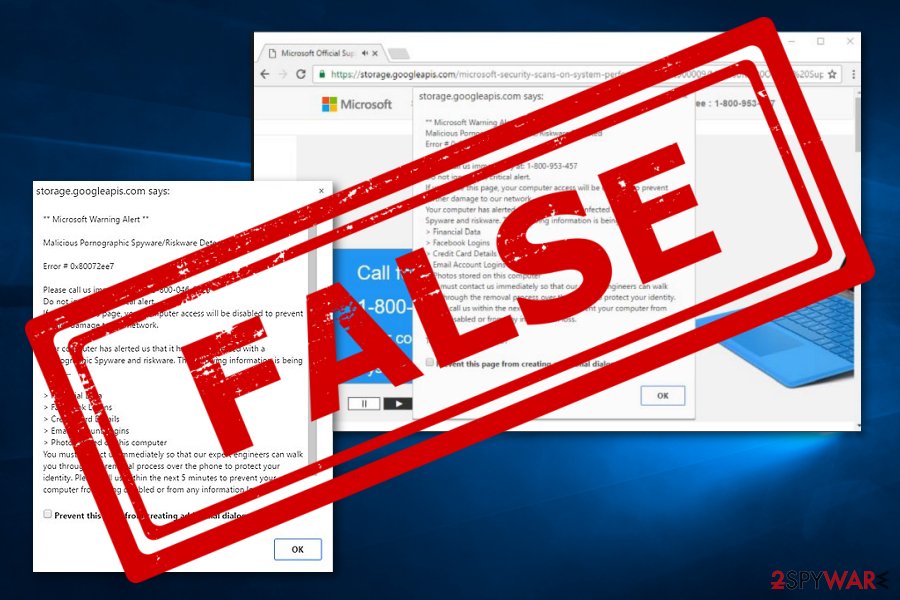
Microsoft Warning Alert virus – a scam that claims false things to trick users and convince them to call the given number

Microsoft Warning Alert virus – a scam that claims false things to trick users and convince them to call the given number
Microsoft Edge virus
Microsoft Edge virus is considered to be potentially unwanted content that aims to scare people for receiving benefits. The warning message appears as a Firewall alert and states that various data is at risk due to the secret infiltration of a computer virus. Calling the Microsoft helpline is claimed to be the only way to avoid possible information exposure.
If you ever receive a message from Microsoft virus, do not fall for believing in its claims. The note states that data such as credentials, banking information, Facebook and Skype logins, various passwords, and email addresses can be easily leaked if the problem is not fixed immediately.
Besides, the crooks threaten people via the fake Microsoft Edge virus message that their private photographies and video clips can be leaked. Nevertheless, potential criminals might have the ability to remotely access the webcam. Warning: do not fall for believing this as the only crooks are the people who have been providing this Microsoft virus message.
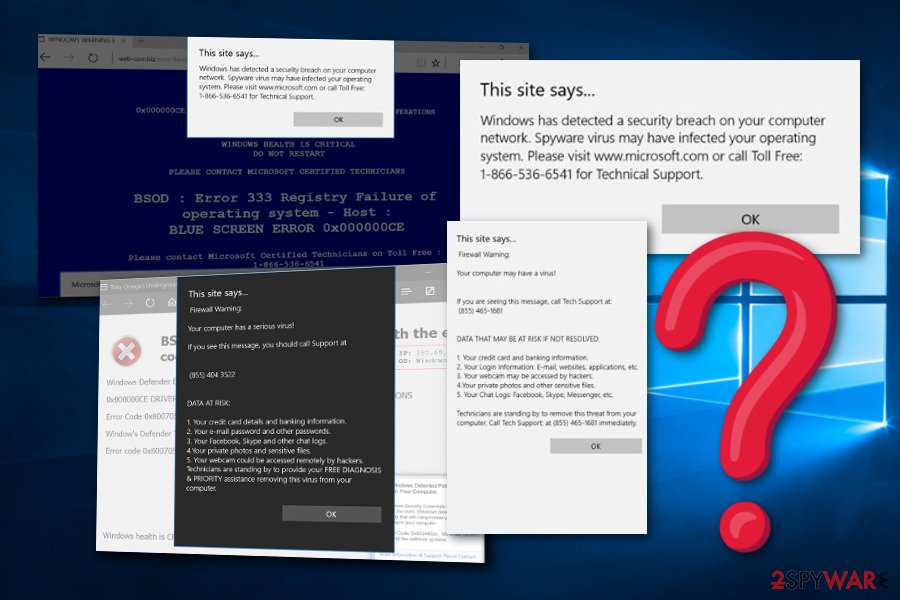
Microsoft Edge virus – a tech support scam that provides a rogue audio file

Microsoft Edge virus – a tech support scam that provides a rogue audio file
“Microsoft Critical Alert”
“Microsoft Critical Alert” appears to be another scam app that misuses the original name of Microsoft Corporation. Scamming and tricking users into dialing the given Microsoft Technical Support number 1-855-813-2335. The suspicious notification claims about a Windows System Alert, that the computer system has been infected and blocked.
Furthermore, the crooks announce that the only way to remove the error and unblock the computer system is by calling the tech support. However, we recommend NOT to do that as “Microsoft Critical Alert” virus does not provide any relevant or true information. You might be tricked by Microsoft virus into revealing personal information when talking with the developers on the mobile phone.
Microsoft Security Essentials Alert virus
Microsoft Security Essentials Alert virus, also known as Hicurdismos, is also another technical support scam. This misleading notification appears while an infectious executable monitors malicious processes in the background. Once users are tricked to install and open a file named “setup.exe”, the virus provides a false BSoD error screen.
Note that legitimate BSoD errors usually disappear after rebooting the computer system. However, crooks behind Microsoft Security Essentials Alert scam urge to call the fake Microsoft Support helpline (1-800-418-4202) in order to receive some information on how to solve the problem. No contact should be made with these scammers even though they will try to create a legitimate look of the error.
Microsoft virus can monitor some different actions just to try to convince users that the problem truly does exist. These types of activities include disabling all processes in the Task Manager section, covering the entire screen with the BSoD error and denying access to any apps, and hiding the mouse cursor.
Your Windows (Microsoft) Computer has been blocked
Your Windows (Microsoft) Computer has been blocked is a misleading message that frequently targets Windows users. This notification also claims false things to trick users into calling the provided helpline number. First of all, the rogue message states that the system includes an error and that browsers might be hijacked.
Nevertheless, Your Windows (Microsoft) Computer has been blocked scam app becomes even scarier when the message alerts about the potential danger of private data and credentials. You can read that credentials and banking data, email logins, Facebook and other popular networks’ logins, and private videos are at risk of exposure.
Microsoft Corporation has blocked your PC
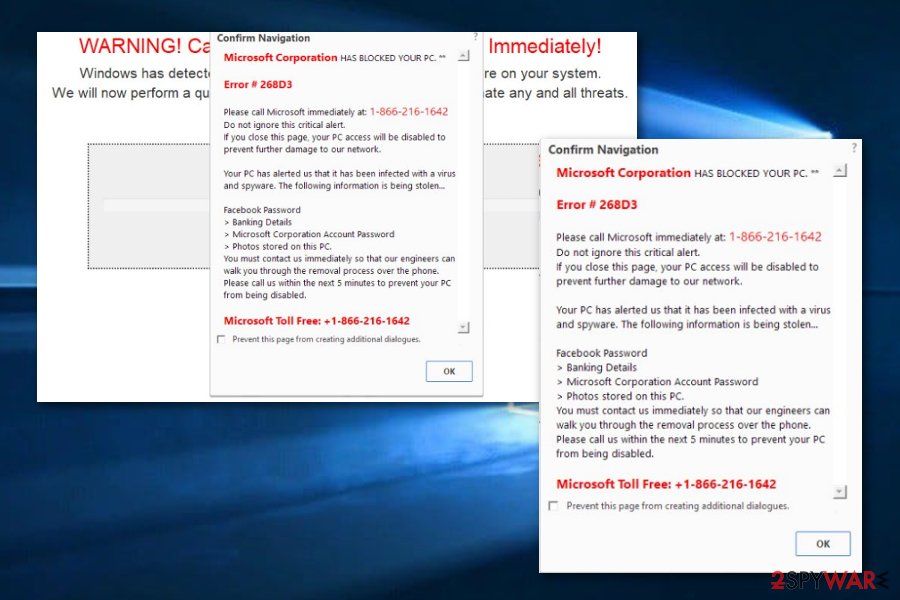

Microsoft Corporation has blocked your PC belongs to the potentially unwanted program, scareware, and technical support scam categories. All of these links are because of the messages misleading content that aims to trick people and also because of its questionable appearance on web browsers.
The claims of Microsoft Corporation has blocked your PC scam are very similar to other scam messages. It starts tricking users that there is possible system damage which might relate to sensitive data exposure of components such as passwords, banking information, and pictures that are kept on the falsely infected machine.
As a fixing solution, the hackers provide a Microsoft Toll Free number that is claimed to help fix all issues. Calling these people is not an option. Note that such tricky Microsoft virus messages can be met anywhere, especially while visiting third-party sources. What you have to do is get rid of all potentially unwanted content from the system.
Microsoft Error: Unknown System Failure
Microsoft Error: Unknown System Failure is considered to be scareware and scamware that infiltrates systems via adware applications or other potentially unwanted programs. The main goal of this questionable message is to provoke users to call fake technical support and try to swindle money for rogue security tools or personal information.
Note that avoiding Microsoft Error: Unknown System Failure virus is the best thing you can do. If the suspicious notification appears only on particular unprotected websites, closing the browser window and never entering that web page again might be what you need for preventing the repeated appearance of the scam.
Microsoft has detected suspicious activity
Microsoft has detected suspicious activity is a technical support scam that operates by using the same principle just like other scam apps. Hackers pretend to be Microsoft support and announce about questionable activities happening on the user’s computer system. These people also report false attempts to steal sensitive information and banking details.
No trust can be found in this scam application. Microsoft has detected suspicious activity is just a fake Microsoft virus that bothers you to swindle the personal data and the money. The removal process might include anti-malware tools or manual steps. However, just do not forget to get rid of the adware or another PUP that is provoking this scam to appear.
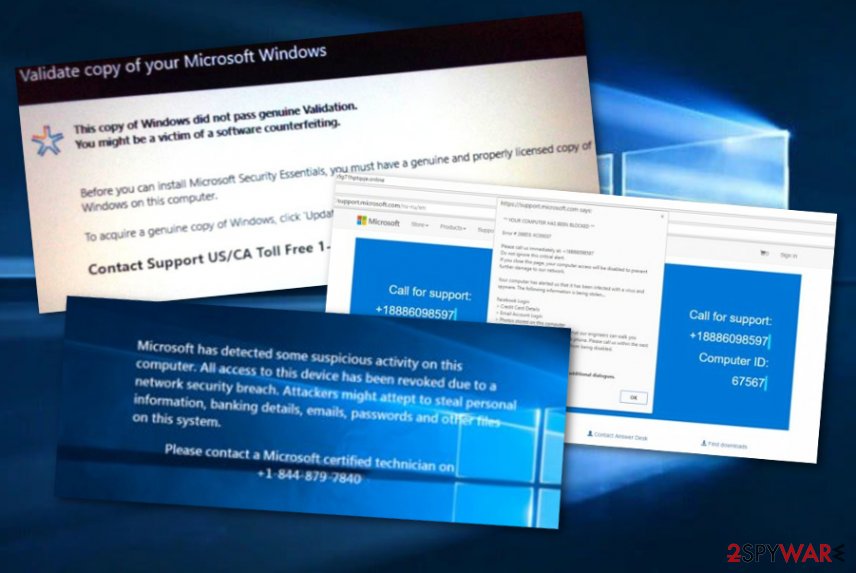
Microsoft tech support scam – a rogue message that appears due to secret adware infiltration or a visit to an unprotected page

Microsoft tech support scam – a rogue message that appears due to secret adware infiltration or a visit to an unprotected page
Validate copy of your Microsoft Windows
Validate copy of your Microsoft Windows – a technical support scam which claims that a certain copy of Windows did not pass genuine validation. In order to receive the original copy, users are urged to click on the “Update Now” button and dial the free support number for further help.
However, we recommend neither clicking on the button nor dialing the fake number as this might put you into some trouble. For example, you might be urged to pay for some fake licensed security software or provide sensitive details about yourself and the computer. Get rid of the adware that is supporting this Microsoft virus and the notification flow should end.
Microsoft.windowssupport0901.online
As a solution, the scammers offer to call technical support via the given mobile phone number and provide the B2957E code for identification. The removal of Microsoft.windowssupport0901.online virus should be your only priority for known. Eliminating the adware app that is causing this scam should solve the problem.
Microsoft.com-input11.info
Microsoft.com-input11.info pop-up ads appear when scamware starts attacking the computer system. These types of notifications can be met on third-party networks or be provoked by adware programs. Once the scam ends up on the victim’s machine screen, it starts claiming about the false browser and computer danger.
Furthermore, +1-844-313-5529, +1-800-610-8993, +1-866-507-946, or +1-855-336-5598 mobile phone numbers are provided as a way to contact the technical support specialists. You should not fall for believing in these fake claims as none of these errors are true. You can figure that out by scanning the entire system with anti-malware.
More danger comes through infected Microsoft Office files
Internet security experts have released a report about infectious Microsoft Office documents that have been lurking out in the cyberspace and carrying malware inside. During September 2018, malware-laden Microsoft Office files were one of the main computer virus distribution techniques that helped the crooks to easily carry malicious software on users’ computers.[4]
Malicious macros who have been inserted in these files carried a big variety of threats in the past. The most popular ones were GandCrab ransomware (one of the most widespread file-encrypting threats throughout the entire malware history), AZORult Trojan horse, Chanitor, and Geodo[5] malware forms.
Infectious but legitimate-looking Microsoft Office documents are spread by using one of the most popular malware distribution techniques – email spam. Such infected macros are attached to a rogue email message and are executed within one click. After that, the malicious payload can successfully be planted on the targeted machine.
Distribution sources and prevention tips (PUPs)
According to technology and virus specialists from Virusai.lt,[6] potentially unwanted programs are capable of spreading via different types of third-party sources and software bundles. Talking about bundling, you can prevent such activity by using reputable sources for your downloads and opting for the Custom configuration mode.
Continuously, you should be aware of suspicious content such as advertisements and hyperlinks that you might meet while browsing throughout the web. If you ever enter a questionable website and you think that it might be infected with some strange malware, e.g Microsoft virus, close it immediately and never return.
Additionally, it is recommendable to carry out regular system check-ups especially after visits to malware-laden pages. If you choose a reputable tool, it will ensure that your computer system is secured 24/7. Also, the more protective features your antivirus includes, the more advanced your machine protection will be.
Removal instructions for different types of Microsoft malware
If the well-known Microsoft name has been misused by a cybercriminal and you have found some type of similar malware on your computer system, you should remove Microsoft virus from your Windows computer system without any hesitation. The most popular type of these viruses is scam apps which can be caused by adware or another potentially unwanted program.
If you have been receiving dubious messages and alerts that pretend to be from Microsoft, you can get rid of them by using automatical tools for adware elimination or the below-given step-by-step guide. These instructions will help you to perform the Microsoft virus removal from your entire Windows operating system.
Furthermore, here you will find how to remove additional components, which are related to Microsoft virus, from your web browsers. Beware of suspicious apps that, after being approved, can inject rogue extensions, plug-ins, and add-ons into such directories. This includes cleaning browsers such as Google Chrome, Mozilla Firefox, Internet Explorer, and Microsoft Edge.
You may remove virus damage with a help of Reimage Reimage Cleaner . SpyHunter 5Combo Cleaner and Malwarebytes are recommended to detect potentially unwanted programs and viruses with all their files and registry entries that are related to them.
This entry was posted on 2020-03-04 at 03:33 and is filed under Malware, Viruses.

